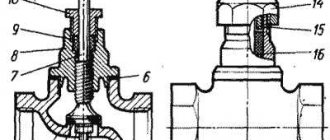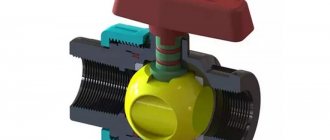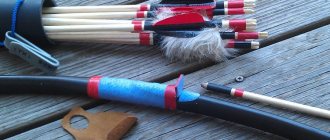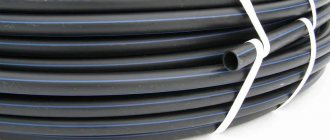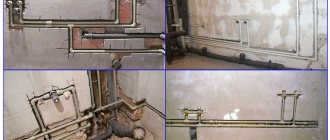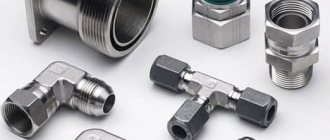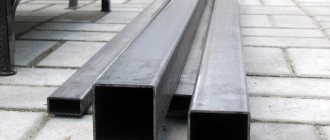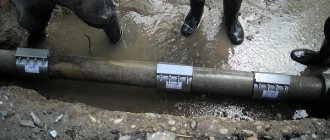If the question of how to clean a metal pipe from rust is being resolved, different methods are considered: mechanical, chemical. The main disadvantage of such communications is their susceptibility to corrosion. Rust can appear inside and outside. In the first case, it is more difficult to remove it, since this often requires the dismantling of communications.
It is easier to clean the pipeline from the outside with your own hands; you do not need to disassemble it for this. To extend the service life of communications, preventive maintenance should be carried out from time to time.
Rusty metal pipe
Why do you need to clean pipes from corrosive deposits?
Rust appears on the walls of metal products upon contact with water in a humid environment. This deteriorates the appearance of the pipe. Gradually, corrosion covers a large surface area and penetrates the structure of the material. This leads to loss of smoothness of the inner walls.
As a result, a large number of rust flakes are formed. The part moves further along the pipe. The remaining particles are retained and compacted, forming hard build-ups. Soon the clearance of communications decreases so much that because of this, the speed of liquid flow significantly decreases, and gradually the water supply stops altogether.
In addition, rusty pipes spoil the interior. If communications pass in open areas, all defects on their surface are visible. The coating gradually deteriorates and rusty spots appear. When corrosion covers a product from different sides (outside, inside), the strength of the metal walls decreases. They become thinner and leaks appear. In this case, cleaning the pipes will not give the desired results. It is necessary to dismantle and then replace communications with new ones.
Fistula sealing in plastic pipelines
Plastic pipe materials have recently been used very often. They quickly replaced conventional steel products, thanks to a wide range of positive characteristics. These materials are not only easy to install, but also easy to repair when fistulas appear.
You can seal a leak on a plastic piece by using couplings and fittings (change part of the line). At the same time, a new piece of pipe with a thread is prepared.
Using connecting elements, it is installed in place of the area that has become unusable. If you are not sure that all actions were performed correctly, you can seek advice from a professional technician.
After inspecting the structure, he will give an accurate answer as to whether it is suitable for use, or will advise a complete replacement of the damaged pipe.
This method can be applied not only to plastic pipes, but also to metal ones. Only it will not be possible to eliminate the fistula in this way under pressure. You will have to worry about turning off the water in the plumbing system.
To ensure that water pressure (find out the optimal values for the plumbing system) does not interfere with repairs, it is necessary to turn off the main valve. It is usually installed in the toilet.
Video: eliminating water leaks in accessible ways
Eliminating water leaks using accessible methods. IT WILL BE USEFUL FOR EVERYONE!
When is pipe cleaning done?
Even if the appearance of the pipeline has not deteriorated, it is recommended to periodically clean the internal walls. This is done to prevent rust. Metal products are regularly painted to prevent signs of rust. In a number of cases, unscheduled cleaning of communications is carried out:
- pockets of rust form on the surface of metal pipes;
- the water pressure has decreased, which is not associated with a decrease in pressure in the water supply system at the facility;
- if a heating system pipe rusts, its internal diameter decreases, and at the same time the quality of heating the room;
- a leak has appeared, but in this case it will be necessary to replace a section of the pipeline, and at the same time carry out preventive cleaning of adjacent communications.
To avoid having to dismantle a rusted pipe, it should be serviced more often. Then the likelihood of a decrease in lumen is reduced.
How to fix leaks in metal pipes
A fistula in a metal pipe with hot water can be quickly repaired using the following methods.
Option 1. Medical bandage and cement solution. It is cut into pieces and soaked in pre-prepared cement mortar. These bandages are wrapped around the leakage area, forming a cocoon-like structure.
Finally, the resulting structure is also covered with cement mortar. It dries in about one day.
Option 2. Pieces of rubber. Rubber is cut into strips. Each of them should be slightly longer than the circumference of the pipe.
Next, the strips are pulled tightly, wrapping the “emergency” zone, and secured with clamps. This method can be used to repair a small fistula even on a damaged section of a heating radiator.
Option 3. Table salt and bandage. As a rule, this method is used to seal pressure leaks in couplings, elbows, etc. The leaking area is wrapped in a bandage mixed with salt.
When dissolved, salt fixes micro-leakage. If we compare this method of sealing under pressure, it is immediately worth noting that it is not as reliable as the first two.
Option 4. Bandage. This method can be used for pressure pipes. The bandage is considered one of the oldest and most proven options. A small car clamp can be used for a fistula with a volume of up to 0.005 cm.
For the clamp, a strip of rubber is cut out, a couple of millimeters wider than it. The length of the strip should be one centimeter shorter than the circumference of the pipeline. The clamp is placed on the pipeline, and a rubber gasket is placed under it.
This entire structure must completely cover the fistula. Next, the clamp is tightened. During these activities, the surface at the site of corrosion must be cleaned.
Video: ways to repair a fistula
How to plug the fistula / How to plug the fistula
It should not contain any irregularities. If this is not done, the liquid will pass through the bandage in the area of uneven areas.
Methods for cleaning rusty pipes
Cleaning pipes from rust is carried out more often if corrosion has already spread to the communications. However, it should be remembered that intense chemical or mechanical exposure can lead to even more severe rusting. If external cleaning is required, the surface can be additionally protected with a coloring compound after the rust removal procedure is completed.
Inside, there is no way to treat communications with special substances. This means that it is recommended to alternate different methods to reduce the degree of aggressive impact on the metal. In addition, to clean the pipe from rust from the inside, you should follow the step-by-step instructions. Then the likelihood of damage to communications is reduced.
Methods
All available options are divided into 2 groups:
- mechanical cleaning;
- chemical
Removing rust using the first method eliminates the use of chemicals. In this case, communications are cleaned with your own hands using a tool. Options for implementing the mechanical method of rust removal:
- Water hammer. This option is suitable for cleaning pipes from the inside. The procedure must be performed by professionals. In this case, layers of rust flakes are removed from the pipe walls using compressed air, which is supplied to the system under high pressure. Special equipment is used for this. In this case, the communications are affected by water hammer. This method has limitations when used. It is necessary to control the pressure so as not to damage the pipeline.
- Sandblasting method. To implement it, a section of the pipeline is dismantled. After this, using special equipment, a stream of compressed air containing abrasive particles is supplied into the communication lumen. Sand can be used for this purpose.
- Abrasives. Water containing solid fractions is supplied to the pipe. When moving through communications under pressure, these particles help clean the internal surface of rust. It is important to use only special abrasive materials with suitable fraction parameters.
- Application of cable. Its cross-section is much smaller than the diameter of the pipe. Thanks to this, the cable moves quite freely through the communications. To increase the efficiency of the method, an electric/pneumatic drill can be used, which will speed up the cleaning process.
If these methods do not provide the desired result or it is not possible to dismantle the pipeline section, chemical methods are used. Improvised and special means can be used. When choosing, you should consider the type of metal. The degree of damage to communications also plays a role.
Facilities
Substances can have different structures and differ in properties. Available options:
- Use of acid: citric or acetic. It is permissible to combine these substances, thereby increasing the effectiveness of the method. So, essence and citric acid are mixed in equal proportions. First, mechanical cleaning is performed. It is necessary to remove flakes of rust to clear the way for liquid to penetrate to the source of corrosion. Then the area is treated with a mixture of acids. The substance is left for several minutes. It is washed off with soapy water.
- Use of caustic soda. You will need 2-3 tbsp. l. substances in any form (powder, gel). The product is placed in the pipe and left for 2 hours. It can be removed from the internal walls of communications using strong water pressure.
- Special products, for example, “Mole”, “Mr. Muscle”. Such substances are highly effective, but they are not recommended for frequent use. Use strictly according to instructions.
You cannot use abrasive substances, mechanical and chemical agents at the same time. In this case, the risk of pipeline damage increases.
How to weld a fistula in a plastic pipe with water
Unlike the previous option, which could be used not only for plastic products, this method is suitable for working with polypropylene pipe products.
The actions are carried out using a special tool for soldering plastic - an iron. This tool melts the prepared components and fastens them after cooling.
To repair minor damage to an area, all repair measures can be carried out under pressure.
But, for a formation of significant size, the water supply system will have to be shut off, since it will be impossible to weld the defect under pressure.
Anyone can operate an iron. No special experience is required for this. Such devices come with instructions that describe the entire operating process step by step.
After reading it carefully, you can safely begin repairing the PP pipeline. It is not difficult to seal a leak this way.
Causes
Condensation is a fairly common occurrence. It mainly forms on cold water pipes. The reasons for this are the presence of high humidity in the room air and the difference between the air temperature and the temperature of the pipeline.
This phenomenon occurs in the same way as dew on the leaves of grass in the morning. Under certain conditions (air humidity, temperature and atmospheric pressure), a so-called “dew point” is formed, upon reaching which the water vapor present in the air settles on the surface of surrounding objects.
Steam also settles on the surface of water pipes, which seem to “sweat”, becoming covered with drops. For this effect to occur, the surface temperature must be lower than the ambient temperature. This is why this happens to cold water pipes in the bathroom and toilet, which are cooled by the passage of a cold flow through them with a temperature lower than the air temperature in the room.
In order to determine the true cause of condensation, it is necessary to determine exactly at what moment it appears, since cooling is associated with the direct movement of water flow.
If water does not flow through the pipe, then the pipe, together with the water in it, heats up to ambient temperature. Under such conditions, condensation cannot form.
Therefore, when water drops are detected on a pipe, you need to accurately determine the location of the source of water movement. This could be a toilet cistern through which water flows unnoticed due to lost or torn gaskets. This movement of water through the pipe is quite sufficient to cool it and form condensate. The source may also be a poor-quality gasket on one of the taps through which the water flows.
In addition, the reason for the formation of water drops may also be found in neighbors who live higher on any of the floors if, for example, their drain tank is leaking. In this case, condensation can form on the water risers passing through the apartments from bottom to top. At the same time, the constant movement of water and, accordingly, cooling of the pipe occurs due to the fault of these leaks. When determining such a cause and wanting to eliminate it, it is necessary to inform the residents who are located above about this.
It should also be taken into account that the formation of condensation on pipes is facilitated by insufficient ventilation or its absence, especially in rooms with high humidity. For example, this can happen in the bathroom, where hot water produces steam, which settles on the pipes in the form of droplets.
Where do leaks most often occur?
Basically, leakage occurs due to improper installation. The joints between pipes and radiators are considered especially weak.
But there is another big point - the wrong choice of material. There is no need to use polypropylene pipes intended only for cold tap water to install heating communications.
As a result, when hot water is supplied, they cannot withstand the resulting pressure, resulting in a leak.
What should you do to rid your heating system of this situation?
Most often, a leak can form at the joints at the place of the connecting seam or the connection of the pipe to the battery.
What to do - advice from professionals to combat this problem
Based on practical experience in dealing with condensate on pipes, experts advise the following:
- Yuri Rogov, a plumber, recommends buying “Gofroterm”, a special composition sold in specialized stores. It is applied to the surface of the pipe, after which a strong elastic film is formed on it, preventing the formation of moisture.
- Andrey Kazantsev, production site foreman, advises purchasing liquid thermal insulation, which is applied like paint to the dried, cleaned surface of the pipeline. According to him, this method is better than thermoflex and other insulating materials.
- If ventilation, plumbing, and water supply are working properly, the cause of condensation accumulation may be the temperature difference between the pipe and the air. Mechanic Nikolai Korotkov advises insulation in this case. To do this, you will need long, hollow inside polyethylene foam covers, or Merylon, which are sold in hardware stores. They are put on the pipeline and secured at the bottom with wire and a clamp.
We recommend watching the video, which shows the reasons and methods of protection against condensation:
There are various ways to get rid of fogging in a cold water supply pipeline. Which one to choose should be determined after analyzing the situation.
If you have the tools and experience, you can do plumbing work yourself, or alternatively, turn to specialists for help.
